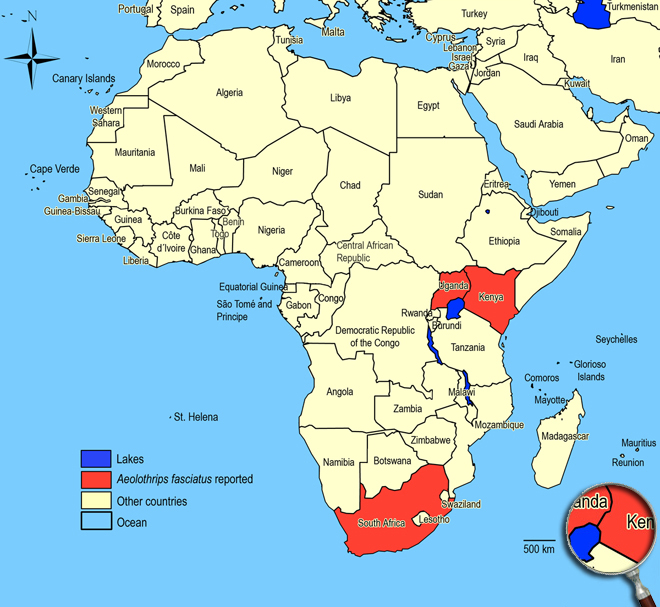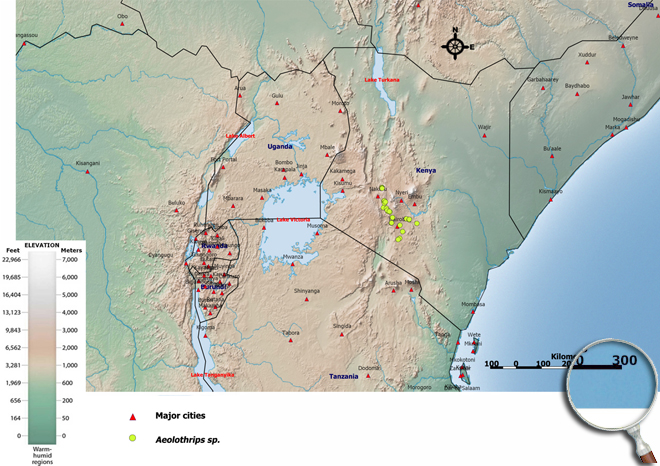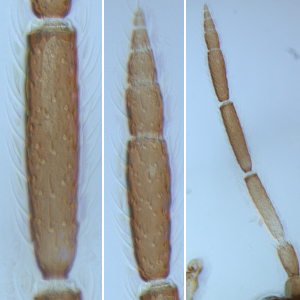Aeolothrips fasciatus (Linnaeus, 1758)
Aeolothripidae, Terebrantia, Thysanoptera
Figures
Fig. 1: Antennal segment IV, terminal segments V-IX, 9-segmented antenna
Fig. 2: Head dorsal with ocellar triangle
Fig. 3: Head ventral with prolonged compound eyes
Fig. 4: Pronotum
Fig. 5: Meso- and metanotum
Fig. 6: Fore wing, distal region of fore wing
Fig. 7: Foreleg with recurved hook
Fig. 8: Tergites V and VI
Fig. 9: Sternites VI-VIII
Fig. 10: Genital and postgenital segments of a female with ovipositor
Fig. 11: Tergites IX-XI (male)
Introduction and recognition
Aeolothrips fasciatus is a facultative predator of small arthropods including larvae of other thrips. Apart from the predatory feeding behaviour, they also survive on pollen. Both sexes are fully winged. Body, legs and antennae dark brown, except antennal segment III yellow with extreme apex brown, antennal segment II yellowish at apex (Fig. 1). Antennae 9-segmented, segment III with linear sense cone near apex rather less than one third as long as segment, on IV linear sense cone about half length of segment and curved distally; segment IV longer than V; segments V-IX forming a single unit with V about the same length as VI-IX together; segments VI-VIII short and almost sub-equal in length. Head and pronotum with no long setae (Fig. 2 and 4); eyes prolonged posteriorly on ventral surface of head (Fig. 3); maxillary palps 3-segmented. Mesonotum with one pair of median setae. Metanotum reticulate medially, median setae near posterior margin (Fig. 5). Fore wings dark with 3 white cross bands, sub-basally, medially and at apex, median band scarcely longer than wing width and shorter than distal dark band; costal vein pale around pale areas of wing (Fig. 6). Fore wing slender with apex rounded, cross veins prominent; costal margin with setae but no cilia. Tarsi 2-segmented, fore tarsus with recurved hamus meeting apex of stout seta (Fig. 7). Tergite I with few transverse striae; all tergites with discal setae small (Fig. 8); tergite X without paired trichobothria or scarcely developed . Sternites IV-VII each with 4 pairs of posteromarginal setae; sternite VII with 2 pairs of small supernumerary setae arising in front of marginal setae S1 and S2 (Fig. 9).
Male smaller than female, tergite I longer than wide with 2 longitudinal ridges; tergite IV & V sometimes with very small paired dorsal tubercles; tergite IX posteroangular setae much longer than paired claspers on this segment.
Taxonomic identity
Species
Aeolothrips fasciatus (Linnaeus, 1758)
Taxonomic history
Aeolothrips justiciae Post, 1961
Aeolothrips atricornis Maltbaek, 1927
Coleothrips trifasciata Fitch, 1855
Thrips fasciata Linnaeus, 1758
Common name
Banded-wing thrips
Present taxonomic position
Family: Aeolothripidae Uzel, 1895
Genus: Aeolothrips Haliday, 1836
Genus description
The genus Aeolothrips Haliday, 1836
Over 90 species are placed currently in the genus Aeolothrips, a genus of the northern temperate zone, of which more than 50 species are from the Palaearctic Region (mainly Europe), and 28 from the Nearctic (mainly western USA). Most of them are flower-living species and seem to be facultative predators, feeding on other thrips and mites as well as on pollen (Mound & Kibby 1998). It is replaced by Desmothrips in Australia, by Allelothrips in Africa, and by Stomatothrips in South America. However, members of these 3 genera all have the sternites bearing discal setae, a character state that is rare in species of Aeolothrips (Moritz et al. 2001). Members of the genus Aeolothrips have 9-segmented antennae, the metanotum is mainly irregular reticulate medially, and the antennal sensoria are linear and simple, sometimes gently undulated, but without scalloped margins.
Species description
Typical key character states of Aeolothrips fasciatus
Coloration and body sculpture
Body color: mainly brown to dark brown
Antennae
Number of antennal segments: 9
Form of sensorium on antennal segment III and IV: linear (gently undulated) along the segment
Length of antennal segment III: about 5 to 6 times as long as wide
Length of antennal segment V: subequal to VI to IX together
Metathorax
Metanotum with dominant sculptured triangle medially: absent
Wings
Fore- and hind wings: present, more than half as long as abdomen
Fore- and hind wing surface: covered with microtrichia
Fore wing shape: mainly parallel sided or margins run continuously towards each other
Fore wing surface: not reticulate
Fore wing veins: present
Fringe cilia arising: from sockets
Fringe cilia on posterior margin near apex: straight
Number of cross veins: 2-4 (5)
Shape of fore wing apex: with continuous rounded margin
Fore wings: alternating bands of dark and light
Fore wing extreme apex color: pale
Abdomen
Ovipositor curved: upwards
Sternites IV, V and VI: with marginal setae but no discal setae
Median posterior marginal setae on sternite VII: with 2 pairs of small supernumerary setae arising in front of marginal setae S1 and S2
Abdominal segment 10: never tubular, longitudinally incomplete ventrally in both sexes

Similar or related species
Aeolothrips fasciatus differs from other Aeolothripidae in having metanotum median area with irregular equiangular reticulation (species of Allelothrips have a metanotum with a distinctive triangular area of striate sculpture; Franklinothrips species without sculpture medially), and no discal setae on sternites III-VI (Franklinothrips and Allelothrips with discal setae laterally on sternites II-VII). Compared to Aeolothrips and Allelothrips which have antennal sensoria on segments III & IV that are linear and simple, those of Franklinothrips are linear and elongate with scalloped margins. Furthermore, Aeolothrips and Allelothrips species possess 4 pairs of posteromarginal setae on sternites III-VII (Aeolothrips fasciatus with 2 pairs of supernumerary setae anterior to marginal setae S1 and S2 on sternite VII), Franklinothrips species possess 2 pairs of posteromarginal setae on sternites III-VI and 4 pairs of posteromarginal setae on sternite VII.
Biology
Life history
As with other thrips species the life cycle from egg to adult is dependent on temperature. The full cycle can take about 15 days (Lewis 1973) to over a month and adults may live for more than one month producing several generations in one year depending on seasonal weather.
Host plants
Found in the flowers of a range of plants, with no recorded specificity.
Crops: African nightshade, alfalfa, beans (broad bean, common bean, French bean, garden pea), buckwheat, cabbage, capsicum, chillies, clover, kale, lily, oats, onion, peach, potato, tobacco, tomato, wheat.
Weeds: Bidens pilosa, Chenopodium sp., Brugmansia suaveolens, Gamolepis chrysanthemoides, Justicia sp., Nycandra physalodes, Pentanisia ouranogyne, Raphanus raphanistrum, Senecio mesogrammoides, Tagetes minuta, Tanacetum cinerariifolium, Tithonia diversifolia.
Vector capacity
None identified.
Damage and symptoms
-
Detection and control strategies
-
Additional notes
As in most Aeolothrips species, the adults and larvae of Aeolothrips fasciatus live in flowers as facultative predators, feeding on small arthropods and presumably on pollen. Aeolothrips fasciatus is described as a predator of Frankliniella occidentalis (Baker 1988), Thrips tabaci (El-Serwiy et al. 1985; Ferrari 1980) and Neohydatothrips variabilis (Robinson et al. 1972).
In California the species has two generations per year. It can live temporarily on plants, but it needs an arthropod diet to complete its preimaginal development (Robinson et al. 1972).
Biogeography
Females identified as this species have been recorded widely around the world, but males have been studied only from Finland, Denmark, Slovakia, Azores, Hokkaido, New Zealand, Tasmania, Kenya, Uganda and South Africa (Northern Cape: Little Namaqualand; Western Cape: Mossel Bay; Eastern Cape: Katberg).
African countries where Aeolothrips fasciatus has been reported

Occurence of Aeolothrips fasciatus in East Africa

Please click here for survey sites of all observed thrips species of Kenya, Tanzania and Uganda.
Click here for locations of Aeolothrips species in parts of East Africa.

Bibliography
Bailey SF (1951). The genus Aeolothrips Haliday in North America. Hilgardia. 21 (2): 43-80
Bailey SF (1957). The thrips of California. Part I: Suborder Terebrantia. Bulletin of the California Insect Survey. 4 (5): 143-220
Baker JR (1988). Biology of the western flower thrips. Proceedings of the IV Conference on Insect and Disease Management on Ornamentals, 1-3 March 1988. Society of American Florists, Kansas City, MO, pp. 79-83
El-Serwiy SA, Razoki IA & Ragab AS (1985). Population density of Thrips tabaci (Lind.) and the predators Orius albidipennis (Reut.) and Aeolothrips fasciatus (L.) on onion. Journal of Agriculture and Water Resources Research. 4 (3): 57-67
Ferrari R (1980). Thrips tabaci injurious to onion crops in Tuscany. Informatore Fitopatologico. 10 (7/8): 27-28
Fitch A (1855). The wheat thrips, Thrips tritici, the three-banded thrips, Coleothrips trifasciata. The Country Gentlemen. 6 (1): 385-386
Hinds WE (1903). Contribution to a monograph of the insects of the order Thysanoptera inhabiting North America. Proceedings of the United States National Museum. 26 (1310): 79-242
Hoddle MS, Mound LA & Paris DL (2008). Thrips of California. Centre for Biological Information Technology, Queensland, Australia, CDROM
Kurosawa M, Takaoka I & Natiô T (1964). Thrips infesting the tobacco plants in Japan (Thysanoptera). Japanese Journal of Entomology (Konchû). 32 (3): 402
Lewis T (1973). Thrips: their biology, ecology and economic importance. Academic Press Inc., London Ltd., 349 pp
Linnaeus C (1758). Systema Naturae, (10th edition). Laurentii Salvii, Holmiae, 823 pp
Moritz G (2006). Thripse. Pflanzensaftsaugende Insekten, Bd. 1, (1. Auflage). Westarp Wissenschaften, Hohenwarsleben, 384 pp. ISBN 13: 978 3 89432 8917
Moritz G, Morris DC & Mound LA (2001). ThripsID - Pest thrips of the world. ACIAR and CSIRO Publishing Collingwood, Victoria, Australia, CDROM ISBN 1 86320 296 X
Moulton D (1936). Thysanoptera from Africa. Annals and Magazine of Natural History, Zoology, Botany and Geology. (Serie 10) 17: 493-509
Mound LA & Kibby G (1998). Thysanoptera: An identification guide, (2nd edition). CAB International, Wallingford and New York, 70 pp
Priesner H (1926-28). Die Thyanopteren Europas. F. Wagner Verlag, Wien, 755 pp
Priesner H (1948). Contributions towards a knowledge of the Thysanoptera of Egypt, XIV (A review of the species of the genus Aeolothrips Hal., pertaining to the Mediterranean fauna). Bulletin de la Société Fouad 1er ďEntomologie. 32: 317-341
Robinson AG, Stannard LJ & Armbrust EJ (1972). Observations on predators of Sericothrips variabilis Beach (Thysanoptera). Entomological News. 83: 107-111
Ruidavets J (1995). Predators of Frankliniella occidentalis (Perg.) and Thrips tabaci Lind.: a review, pp. 43-87. In Loomans AJM, van Lenteren JC, Tommasini MG, Maini S & Riudavets J [eds.], Biological control of thrips pests. Wageningen Agricultural University Papers 95-1. Veenman Drukkers, Wageningen, The Netherlands
Singh S (1946). Studies on the systematics of Indian Thysanoptera - Terebrantia. Indian Journal of Entomology. 7: 147-188
Stannard LJ (1968). The thrips, or Thysanoptera, of Illinois. Illinois Natural History Survey Bulletin. 29 (4): 214-552
Uzel H (1895). Monographie der Ordnung Thysanoptera. Uzel, Königgrätz, 473 pp
von Oettingen H (1942). Die Thysanopteren des norddeutschen Graslandes. Entomologische Beihefte aus Berlin-Dahlem. 9: 79-141
zur Strassen R (1960). Catalogue of the known species of South African Thysanoptera. Journal of the Entomological Society of Southern Africa. 23 (2): 321-367
zur Strassen R (1976). La fauna terrestre de ľile de Sainte-Hélène III - 18. Thysanoptera. Annales de la Musee Royal de ľAfrique Central, Serie 8, Sciences Zoologiques. 215: 236-256
----
Web links
Mound´s Thysanoptera pages
Thysanoptera Checklist
ICIPE Thrips survey sites
UNI Halle & Thrips sites
Thrips of California















